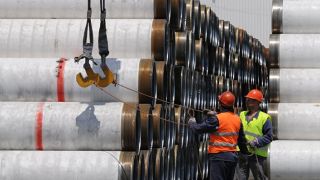There was no wind in Europe and electricity prices soared. The shutdown of wind farms had to be compensated by gas generation. In Germany, prices during peak hours increased by 8 times. Experts believe that this is a wake-up call for the region.
If on Sunday the maximum price for wholesale electricity in Germany during peak hours was no more than 128 euros per MWh, then on Wednesday, November 6, it already reached 805-820 euros per MWh. That's how much wholesale electricity cost from 18.00 to 20.00, according to the NordPool exchange.
The maximum prices have become record since the peak of the energy crisis in 2022. And the reason was the windlessness. This period is called Dunkelflaute, when static high-pressure systems cause weaker than usual winds. According to the Institute of Solar Energy Systems. According to Fraunhofer, the share of wind generation in Germany has fallen from an annual average of 32% to almost zero. Wind turbines operate at only 7% of their capacity.
Approximately the same thing happened in Great Britain. According to National Grid: live, the wind generation of Foggy Albion has decreased to 7.6%.
At the same time, the share of gas generation has grown to 60% in the UK, and to almost 30% in Germany. For the latter, this is a three-fold jump.
And since the price of gas in Europe is still more than twice the pre-crisis quotes ($ 460 on the TTF exchange), the price of electricity production has soared.
At the same time, the operator of the Polish power system, PSE, declared an emergency situation and obliged all reserve power plants to use their capacity on demand. According to PSE, on November 6, gas and coal-fired power plants account for 95% of all electricity production in the country.
"While Europe is striving to rapidly expand its wind and solar energy production capacities, it still relies on expensive hydrocarbons as a reserve. One of the biggest challenges of the region is to ensure the availability of cheap, clean energy at any time when it is needed," Bloomberg noted.
Alexey Grivach, Deputy Director of the National Energy Security Fund (NWF), believes that the current calm in Europe is a bell that rings from time to time as a reminder to European dreamers about the harsh truth of life.
"Windlessness combined with cold weather in February will have much more serious consequences for the energy system with the current share of wind and solar energy. And even more so in combination with other negative factors." — the expert notes.
As EADaily reported, due to sanctions and counter-sanctions, Gazprom reduced supplies to Europe by about five times. At the same time, Russian pipeline fuel continues to be one of the most competitive. While maintaining only two export routes, Gazprom increased supplies to Europe by 15% in 10 months of the year. The company's customers have increased the selection of Russian gas to 26.5 billion cubic meters. Half of the increase came from Greek companies.

 The Supreme Court of Venezuela named the head of state
The Supreme Court of Venezuela named the head of state Trump's attack on Venezuela is illegal and unwise — NYT
Trump's attack on Venezuela is illegal and unwise — NYT Trophy: Trump posted a photo of Maduro aboard an American ship
Trophy: Trump posted a photo of Maduro aboard an American ship Brazilian President: Trump has crossed the boundaries of what is acceptable
Brazilian President: Trump has crossed the boundaries of what is acceptable The capture of Maduro lasted half an hour: agreed or not?
The capture of Maduro lasted half an hour: agreed or not? Nothing is over in Venezuela yet: The US operation continues
Nothing is over in Venezuela yet: The US operation continues